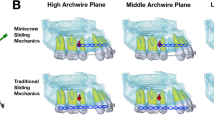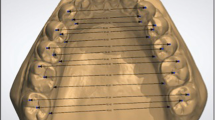Abstract
Objectives
The aims of this study were to compare the effect of 4 bracket systems including Alexander, Roth, MBT, and Gianelly on upper anterior retraction and to quantify the amount of torque loss ratio in sliding mechanics by help of a 3-dimensional (3D) finite element method.
Method and materials
3D FEM models were constructed in order to simulate anterior incisor retraction in first premolar extraction case. Displacement, stress, and strain on the incisal edge and apex of maxillary central incisor were calculated when 1-, 2-, and 3-N retraction forces were applied. Torque loss ratio was calculated by measuring the displacement of the teeth at crown tip and root apex in all 4 bracket systems on upper central incisor.
Results
Uncontrolled lingual crown tipping of the incisor was observed in all bracket systems. The crown moved lingually by 9.5 μm and the root labially by 4.5 μm in MBT system with 3-N retraction force. The amount of crown movement was 8 μm and the root displacement was 4 μm in Gianelly system with the same retraction force. Torque loss ratio was 1.46 in Alexander and Gianelly with 3-N retraction force. However, the amount of torque loss ratio was 1.47 in MBT and Roth with the same retraction force.
Conclusions and clinical Relevance
Uncontrolled tipping was the least in Gianelly and was the highest in MBT. The amount of torque loss ratio was the lowest in Gianelly and Alexander systems and the amount of torque loss ratio was the highest in MBT system.








Similar content being viewed by others
References
Sia S, Koga Y, Yoshida N (2007) Determining the center of resistance of maxillary anterior teeth subjected to retraction forces in sliding mechanics. An in vivo study. Angle Orthod 77(6):999–1003. https://doi.org/10.2319/112206-478
Sia S, Shibazaki T, Koga Y, Yoshida N (2009) Experimental determination of optimal force system required for control of anterior tooth movement in sliding mechanics. Am J Orthod Dentofac Orthop 135(1):36–41. https://doi.org/10.1016/j.ajodo.2007.01.034
Moore JC, Waters NE (1993) Factors affecting tooth movement in sliding mechanics. Eur J Orthod 15(3):235–241
Barlow M, Kula K (2008) Factors influencing efficiency of sliding mechanics to close extraction space: a systematic review. Orthod Craniofac Res 11(2):65–73. https://doi.org/10.1111/j.1601-6343.2008.00421.x
Kojima Y, Fukui H (2010) Numeric simulations of en-masse space closure with sliding mechanics. Am J Orthod Dentofac Orthop 138(6):702 e701–702 e706; discussion 702-704. https://doi.org/10.1016/j.ajodo.2010.06.015
Perillo L, Sorrentino R, Apicella D, Quaranta A, Gherlone E, Zarone F, Ferrari M, Aversa R, Apicella A (2010) Nonlinear visco-elastic finite element analysis of porcelain veneers: a submodelling approach to strain and stress distributions in adhesive and resin cement. J Adhes Dent 12(5):403–413. https://doi.org/10.3290/j.jad.a18394
Reimann S, Keilig L, Jaeger A, Bourauel C (2007) Biomechanical finite-element investigation of the position of the centre of resistance of the upper incisors. Eur J Orthod 29(3):219–224. https://doi.org/10.1093/ejo/cjl086
Matsui S, Caputo AA, Chaconas SJ, Kiyomura H (2000) Center of resistance of anterior arch segment. Am J Orthod Dentofac Orthop 118(2):171–178. https://doi.org/10.1067/mod.2000.103774
Parashar A, Aileni KR, Rachala MR, Shashidhar NR, Mallikarjun V, Parik N (2014) Torque loss in en-masse retraction of maxillary anterior teeth using miniimplants with force vectors at different levels: 3D FEM study. J Clin Diagn Res 8(12):ZC77–ZC80. https://doi.org/10.7860/JCDR/2014/10099.5353
Tominaga JY, Ozaki H, Chiang PC, Sumi M, Tanaka M, Koga Y, Bourauel C, Yoshida N (2014) Effect of bracket slot and archwire dimensions on anterior tooth movement during space closure in sliding mechanics: a 3-dimensional finite element study. Am J Orthod Dentofac Orthop 146(2):166–174. https://doi.org/10.1016/j.ajodo.2014.04.016
Kusy RP, Whitley JQ, Prewitt MJ (1991) Comparison of the frictional coefficients for selected archwire-bracket slot combinations in the dry and wet states. Angle Orthod 61(4):293–302. https://doi.org/10.1043/0003-3219(1991)061<0293:COTFCF>2.0.CO;2
Nyashin YI, Nyashin M, Osipenko M et al (1999) Center of resistance and center of rotation of a tooth:the definitions, conditions of existence, properties. Russ J Bioorg Chem 1(1):1–11
Perillo L, Jamilian A, Shafieyoon A, Karimi H, Cozzani M (2015) Finite element analysis of miniscrew placement in mandibular alveolar bone with varied angulations. Eur J Orthod 37(1):56–59. https://doi.org/10.1093/ejo/cju006
Tominaga JY, Chiang PC, Ozaki H, Tanaka M, Koga Y, Bourauel C, Yoshida N (2012) Effect of play between bracket and archwire on anterior tooth movement in sliding mechanics: a three-dimensional finite element study. J Dent Biomech 3:1758736012461269. https://doi.org/10.1177/1758736012461269
Nucera R, Gatto E, Borsellino C, Aceto P, Fabiano F, Matarese G, Perillo L, Cordasco G (2014) Influence of bracket-slot design on the forces released by superelastic nickel-titanium alignment wires in different deflection configurations. Angle Orthod 84(3):541–547. https://doi.org/10.2319/060213-416.1
Crincoli V, Perillo L, Di Bisceglie MB, Balsamo A, Serpico V, Chiatante F, Pappalettere C, Boccaccio A (2013) Friction forces during sliding of various brackets for malaligned teeth: an in vitro study. ScientificWorldJournal 2013:871423. https://doi.org/10.1155/2013/871423
Lombardo L, Arreghini A, Bratti E, Mollica F, Spedicato G, Merlin M, Fortini A, Siciliani G (2015) Comparative analysis of real and ideal wire-slot play in square and rectangular archwires. Angle Orthod 85(5):848–858. https://doi.org/10.2319/072214-510.1
Acknowledgments
The authors wish to express appreciation to support of the American Orthodontics (USA) and Dentaurum Company (Germany) for supporting the bracket geometry basis for the FE models.
Author information
Authors and Affiliations
Corresponding author
Ethics declarations
Conflict of interest
The authors declare that they have no conflict of interest.
Ethical approval
This article does not contain any studies with human participants or animals performed by any of the authors.
Informed consent
For this type of study, formal consent is not required.
Additional information
Publisher’s note
Springer Nature remains neutral with regard to jurisdictional claims in published maps and institutional affiliations.
Rights and permissions
About this article
Cite this article
Cozzani, M., Sadri, D., Nucci, L. et al. The effect of Alexander, Gianelly, Roth, and MBT bracket systems on anterior retraction: a 3-dimensional finite element study. Clin Oral Invest 24, 1351–1357 (2020). https://doi.org/10.1007/s00784-019-03016-6
Received:
Accepted:
Published:
Issue Date:
DOI: https://doi.org/10.1007/s00784-019-03016-6




